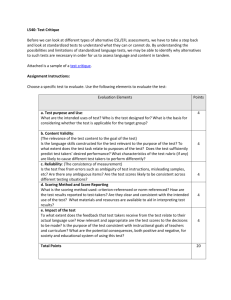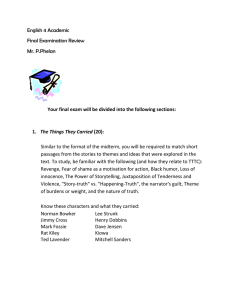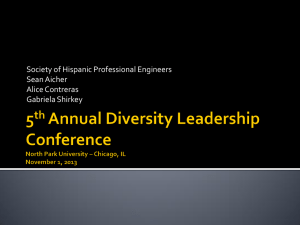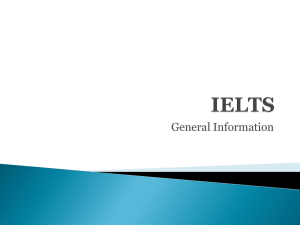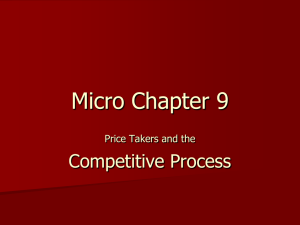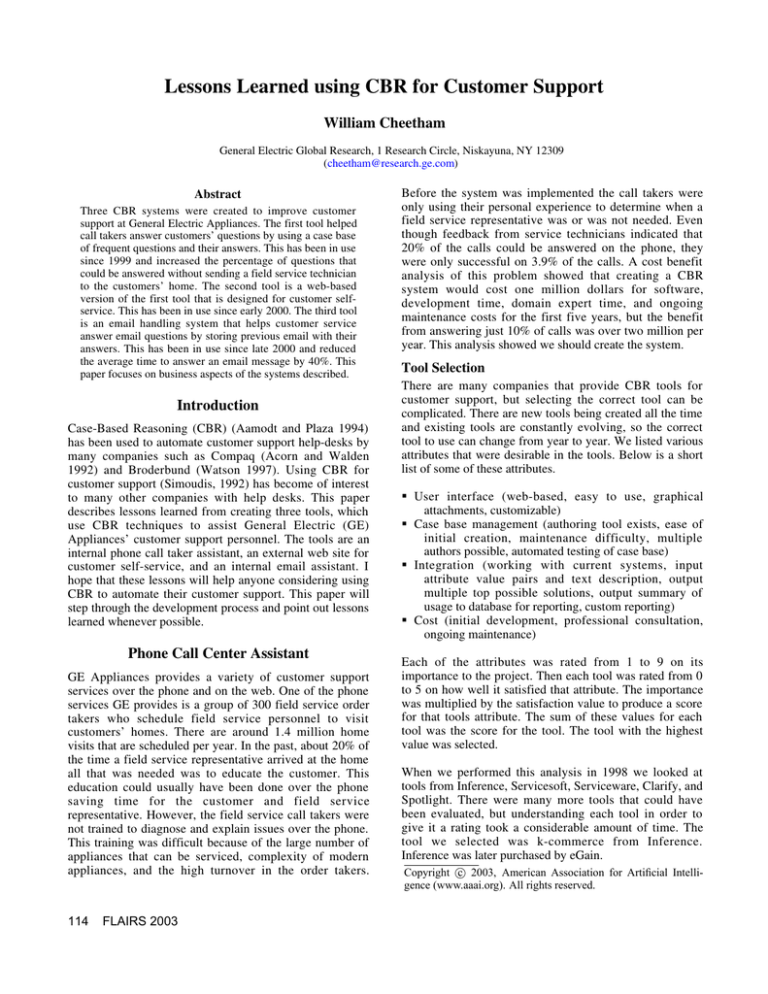
Lessons Learned using CBR for Customer Support
William Cheetham
General Electric Global Research, 1 Research Circle, Niskayuna, NY 12309
(cheetham@research.ge.com)
Abstract
Three CBR systems were created to improve customer
support at General Electric Appliances. The first tool helped
call takers answer customers’ questions by using a case base
of frequent questions and their answers. This has been in use
since 1999 and increased the percentage of questions that
could be answered without sending a field service technician
to the customers’ home. The second tool is a web-based
version of the first tool that is designed for customer selfservice. This has been in use since early 2000. The third tool
is an email handling system that helps customer service
answer email questions by storing previous email with their
answers. This has been in use since late 2000 and reduced
the average time to answer an email message by 40%. This
paper focuses on business aspects of the systems described.
Introduction
Case-Based Reasoning (CBR) (Aamodt and Plaza 1994)
has been used to automate customer support help-desks by
many companies such as Compaq (Acorn and Walden
1992) and Broderbund (Watson 1997). Using CBR for
customer support (Simoudis, 1992) has become of interest
to many other companies with help desks. This paper
describes lessons learned from creating three tools, which
use CBR techniques to assist General Electric (GE)
Appliances’ customer support personnel. The tools are an
internal phone call taker assistant, an external web site for
customer self-service, and an internal email assistant. I
hope that these lessons will help anyone considering using
CBR to automate their customer support. This paper will
step through the development process and point out lessons
learned whenever possible.
Phone Call Center Assistant
GE Appliances provides a variety of customer support
services over the phone and on the web. One of the phone
services GE provides is a group of 300 field service order
takers who schedule field service personnel to visit
customers’ homes. There are around 1.4 million home
visits that are scheduled per year. In the past, about 20% of
the time a field service representative arrived at the home
all that was needed was to educate the customer. This
education could usually have been done over the phone
saving time for the customer and field service
representative. However, the field service call takers were
not trained to diagnose and explain issues over the phone.
This training was difficult because of the large number of
appliances that can be serviced, complexity of modern
appliances, and the high turnover in the order takers.
114
FLAIRS 2003
Before the system was implemented the call takers were
only using their personal experience to determine when a
field service representative was or was not needed. Even
though feedback from service technicians indicated that
20% of the calls could be answered on the phone, they
were only successful on 3.9% of the calls. A cost benefit
analysis of this problem showed that creating a CBR
system would cost one million dollars for software,
development time, domain expert time, and ongoing
maintenance costs for the first five years, but the benefit
from answering just 10% of calls was over two million per
year. This analysis showed we should create the system.
Tool Selection
There are many companies that provide CBR tools for
customer support, but selecting the correct tool can be
complicated. There are new tools being created all the time
and existing tools are constantly evolving, so the correct
tool to use can change from year to year. We listed various
attributes that were desirable in the tools. Below is a short
list of some of these attributes.
User interface (web-based, easy to use, graphical
attachments, customizable)
Case base management (authoring tool exists, ease of
initial creation, maintenance difficulty, multiple
authors possible, automated testing of case base)
Integration (working with current systems, input
attribute value pairs and text description, output
multiple top possible solutions, output summary of
usage to database for reporting, custom reporting)
Cost (initial development, professional consultation,
ongoing maintenance)
Each of the attributes was rated from 1 to 9 on its
importance to the project. Then each tool was rated from 0
to 5 on how well it satisfied that attribute. The importance
was multiplied by the satisfaction value to produce a score
for that tools attribute. The sum of these values for each
tool was the score for the tool. The tool with the highest
value was selected.
When we performed this analysis in 1998 we looked at
tools from Inference, Servicesoft, Serviceware, Clarify, and
Spotlight. There were many more tools that could have
been evaluated, but understanding each tool in order to
give it a rating took a considerable amount of time. The
tool we selected was k-commerce from Inference.
Inference was later purchased by eGain.
c 2003, American Association for Artificial IntelliCopyright °
gence (www.aaai.org). All rights reserved.
Case Description
After k-commerce was selected the first step was to create
a style guide that set down strict formats for the cases that
would be created. Each case could have a title, description,
questions, actions, and attachments. The style guide set a
format for each of these. For example, each case was
created with an HTML attachment in a standard look and
feel that described the action to be taken when the case is
selected. The style guide allowed multiple authors to work
together and produce a consistent result.
Gathering the Data
Before the case base could be created we needed to collect
the information that would go into the cases. The
information was in many forms
A list of the top 5 issues for each type of appliance
A database that includes everything from a list of all
model numbers to the address of every repair person
Paper repair manuals
Paper flyers that had been sent to the call takers
Call taker training manuals
Reports on calls received for the last year
Feedback from field service technicians on what work
was performed
Undocumented knowledge of engineers and call takers
An initial collection, organization, and understanding of
this information took two people two months. The most
important information was probably the feedback from the
field service technicians. This feedback showed that on
20% of their service calls they did not perform any work
on the appliance and only gave information to the
customer. The feedback gave an estimate of the frequency
of each repair or piece of information that was the result of
the service call. This allowed us to know what were the
most frequent issues, which would be stressed in the case
base. The 80-20 rule held that 80% of the calls were on
20% of the issues. These most frequent 20% were
emphasized.
caused the loss of the understanding of the tradeoffs that
were made in creating the case base. We had a team of four
people. Two team members who had technical writing and
call taking skills were planned to be the knowledge
managers after the system goes into production. Two team
members with AI and computer science skills were only
going to work on the project until its success was proven.
This worked well.
In addition to the four case authors there were a variety of
engineers and call takers who provided undocumented
knowledge that should be included in the case base. At first
we met with the engineers in separate meetings from the
call takers. It was quickly apparent that the two groups of
people had different knowledge to offer. The engineers
could explain the issues that should be stored as cases in
detail and the call takers could explain which issues are
most common and how to communicate this to the
customers. Our most successful knowledge acquisition
meetings had both engineers and call takers.
CBR vs. Decision Tree
One of k-commerce’s features is that questions can be
attached to cases. The questions allow the appropriate case
to be selected by answering the questions that differentiate
the possible cases. For our application we wanted to be
able to suggest one and only one case as the solution. A
way to guarantee that these questions can differentiate
every case in the case base is to form a tree of questions
over the case base where each case is a leaf in the tree and
each internal node in the tree is a unique question. We
consider this approach as both a decision tree and CBR
methodology. The decision tree is simply the selection
mechanism of the CBR system. Figure 1 shows a decision
tree where rectangles are questions, parallelograms are
answers, ovals are solutions, and circles are indicators that
the decision tree is continued on another page.
Which refrigerator
compartment is too cold?
Freezer
On what setting is the
freezer compartment
temperature?
A, B, 1, 2, or 3
The gathering of data was not a one-time event. The initial
case base was created for just one type of appliance,
refrigerators. Later, case bases were created for all types of
appliances. When new products are introduced or new
issues are detected with existing products the case base
needs to be maintained.
Selecting the Authors
After the initial gathering of data was finished we needed
to create the case base. I believe one of the most important
decisions was selecting who the case authors would be.
Since the case authoring is not a one-time event it was very
important to get the people who would be in charge of
maintaining the knowledge in the case base involved at the
beginning of the case base creation. The alternative
approach of having someone develop a prototype and then
hand it off to someone else for maintenance would have
More than 3 or C
Fresh
Food
Schedule
service
Lower freezer compartment temperature setting;
Wait 24 hours to see if problem solved
What type of refrigerator do you
have? Is the freezer on the top,
bottom, or side?
Continued
Side by
Side
Side
Continued
Bottom
Mount
Bottom
Top
Is there one door on
the outside or two?
Continued
Cycle
Defrost /
Manual
One
Two
Do you defrost the
freezer yourself?
No
Yes
Continue
TMNF
Continued
Cycle Defrost
/ Manual
Figure 1: Decision Tree
FLAIRS 2003
115
Requiring a full tree has other benefits. k-commerce has a
case-tree authoring tool that allows for a visual creation of
a question/answer tree. This tool allows a case author to
construct a tree by dragging questions onto an existing tree.
The tree is represented as an indented list of questions. A
case is automatically created at each leaf of the tree with
the appropriate questions attached. This greatly reduced the
difficulty in attaching questions to cases.
Although Inference’s case-tree authoring is an excellent
tool, we found Visio was a better graphical tool for
knowledge acquisition. One of our knowledge acquisition
sessions would typically involve two engineers, two call
takers, and two case authors. The case authors had a
computer with a video projector. One case author would
lead the engineers and call takers through the creation of a
decision tree while the second author created the tree in
Visio . Once the Visio decision tree was finalized it was a
trivial process to create the case base with the case-tree
authoring tool.
important ones are asked first reduced the depth of trees by
widening them.
After the pilot test was completed we needed to train the
users. The 300 call takers were split into three groups at
three different locations within the United States. Training
material was created and a local expert was identified at
each location. We rolled the tool out to the different
locations one at a time, with about a month between
rollouts. We checked with each call taker to see if they had
any problems with the tool and used the reporting database
to see if the call takers were not using the tool properly.
During this time the call takers found some cases that
needed to be added or changed. We gave these changes a
high priority and were usually able to update the case base
quickly when an issue was identified. Answering questions
and fixing issues quickly helped win the acceptance of the
call takers.
Pilot Test
After the case base was created we had a two month pilot
test. The user interface of the pilot system is shown in
Figure 2. Eight call takers used the tool during the pilot.
Every time the case base was used to answer a call a
description of the call was written to a reporting database.
The description included start time, end time, caller phone
number, call taker ID, type of appliance, short text
description of issue, all questions asked by CBR, all
answer given to these questions, case suggested, and if this
answer was accepted by the caller. Each week a case
author would analyze this information in the reporting
database for every call that was taken for the week. The
author was looking for any trends and especially any times
a caller would not be satisfied by a suggestion. Any trends
or outstanding items would be discussed in a weekly
feedback meeting with the call takers. The result of the
feedback meetings would be a few changes in the case
base. These changes would be made immediately and
reviewed in the next weeks meeting. The call takers were a
valuable part of the development team and felt ownership
in the case base when the pilot test was finished.
One of the issues we found in the pilot test was that callers
really did not like answering a lot of questions. If an issue
could be identified in about four questions then they were
usually happy to answer them. However customers were
sometimes frustrated answering more questions. Some of
our initial decision trees were up to twelve questions deep.
We reduced the number of questions needed to diagnose an
issue by automating some questions, combining some
questions, and changing the order of other questions.
Questions, like “what is your model number?” were
automated by creating a database with information on each
customer. Multiple simple questions in a row were
combined. Changing the order of questions so that the most
116
FLAIRS 2003
Figure 2: Internal Pilot User Interface
Maintenance
The maintenance actually started before the tool was
released. Planning for the maintenance is a key factor in
the tool’s success. There is a half-life for the knowledge
that is represented in the tool. If that knowledge is not
updated it will soon become obsolete.
In General Electric there is a set process for the steps that
need to be taken when new products are introduced. We
needed to have an extra step inserted into this process for
maintenance of the case base. When a new product was
finished with its field test and was ready to be sold the
team releasing the product needed to help the case authors
create or update the case base for that product. This is
important because many questions are on new products and
it would be better to have that information ready for the
customers before they even ask the first question. An
example of this is that GE released the Advantium range
right after this tool was rolled out.
Other companies have used k-commerce and developed
methods of gathering data. Thompson Consumer
Electronics Inc., which manufactures and markets GE
branded electronics, has used k-commerce for their call
center (Thomas et. al. 1997). They have a group of case
authors that are split into two groups, people who add cases
to the case base “knowledge authors” and people who find
new data for cases “hunter gatherers.” Our case authors
worked with domain experts to create the decision trees, as
in Figure 1, then authored the cases after the trees were
finalized.
Results
The system was deployed to the 300 order takers in June of
1999. The percentage of calls that could be correctly
answered over the phone, without sending a field service
representative, increased from 3.9% to 12.3%. The
average call times decreased slightly, from 256 seconds to
232 seconds. Since each service call that is handled over
the phone saves over $25 the system has resulted in a
savings of over $2.5 million per year. The cost of
development, including time of developers and purchased
software, was $1.2 million. Surveys of customer
satisfaction also showed the customer preferred having
their issues solved without the need for a house visit.
Web Self-Service
After the call taker support tool proved successful, the next
step was to make the k-commerce based tool available to
our customers by placing it on a public web site. This
allows customers to have direct access to the information
they need. Figure 3 shows the first screen of this tool.
instructions for the call takers, and proprietary information
that all had to be removed. New graphics and information
needed to be added. Finally, there needed to be a way for
customers to get help if they could not find what they
wanted in the case base.
The modifications needed were made in a few months, but
the case base is constantly growing and changing. The web
self-service tool was made available on the
http://www.geappliances.com/geac/schdl_rpr/solve.htm
web site in early 2000. The benefits of the web self-service
were difficult to calculate, so we do not claim any here.
We found that when a self-service web site is created you
want most of the possible questions to be handled by the
tool when it is first rolled out. If the tool does not answer a
significant number of issues then people will not use it.
Taking time to perfect the tool before its release is time
well spent. First creating an internal call-taker tool is a
good way to test out the public one. When the internal tool
gets to the point that it can handle most of the calls and
little training is needed for someone to start using it, then it
is ready to be transformed into a self-service tool.
Maintenance
The maintenance of knowledge in a tool is important.
When multiple tools use the same knowledge the
maintenance becomes even more important. You do not
want to maintain the same knowledge in multiple systems.
When any new system is created it should be able to
leverage the knowledge that is being maintained in another
tool. You really want to have one central repository for
knowledge that each system would access. Otherwise you
could end up with many inconsistent knowledge bases that
are difficult to maintain.
If issues were not in the case base, customers could phone
or email the call center with the question. The email acted
as feedback on which cases were the most important to
add. Each email could be considered a defect in the case
base. Either the information requested did not exist or the
customer was unable to find it. That information should be
added if it was missing or restructured if it could not be
found.
Email Response Automation
Figure 3: Public User Interface
Case Base Development for Self Service
Even though the call taker support tool was a web-based
application there were some changes that were needed to
deploy it for use by our customers. The user interface
needed to be improved. The cases contained jargon,
The down side of asking people to send in email with
questions is that you then have to answer all the email
messages. We found that it actually took longer for a
person at the call center to answer an email message than a
phone message. An email message is a recorded piece of
information, so more care was needed in the wording than
was used in a phone conversation. Therefore, we also
needed a tool for answering the email messages.
FLAIRS 2003
117
Figure 4: email Case
Tool Selection
There are several commercial tools for automating the
response to email messages. Some of these companies
include Kana, eGain, and Cisco. We went through the same
process described earlier and selected Cisco’s email
manager tool. This tool stores replies to frequently asked
questions so that they can be reused on future similar
questions. In order to select the appropriate reply a decision
tree is created where each node in the tree is a rule about
the keywords and text in the email message. Each leaf node
in the decision tree specifies a set of replies that can be
used to answer that specific type of email message.
When vendors give their pitches to sell their email
handling tools they claim you can automatically answer a
percentage of your email messages. This is wrong.
Anything that can be automated should be a tool on a web
page. The email handling tool can be a temporary remedy
until that web-based tool is created, but should not be a
long term solution. On the other hand, auto-suggesting
answers is a good thing. Having solutions automatically
suggested to a person who then just selects the correct
response from a list of suggestions allows you to handle the
special cases that can not be addressed easily on a web
page.
Simplifying the Problem
Understanding a free text email message is difficult for an
automated system. The first thing we did was to make the
problem of understanding an email message easier. Instead
of having customers send email directly to us, we made
them enter it on a form on our web site. All email
addresses on our products were replaced with web pages.
In addition to the free text of the email the customer
needed to classify their message based on a few pull-down
menus on the web site. This self-classification of the email
made it much easier for an automated system to select
similar cases.
In the section on web self-service I mentioned that the tool
should have most of the information needed before it is
released. The email handling tool is different. It can be
released with a reasonable amount of information. When a
question is found where a solution does not exist, the new
solution that is created can be added to the tool. The
customer gets quick service either way. Since most easy
questions can be answered by the stored solutions, there is
more time to answer complicated questions. Questions that
are repeated can be added to the web self-service tool.
Results
Figure 4 shows a case from the email manager. A customer
emailed GE saying they have a fifty year old refrigerator in
perfect working condition and asked if we would like to
purchase it from them. The reply to this email was stored in
the case base and is now used about two times per week.
Customer support personnel either send this exact reply or
edit it if the request was slightly different. The case is
given keywords that help in case selection.
Our implementation of Cisco’s email tool went into use in
June of 2000. The tool reduced the average time a person
needs to answer an email message by 40%. Since our
yearly projected cost to answer email was $1.5 million, the
savings of this tool is $600,000 per year.
Conclusion
Customer support technology can provide many benefits.
Several tools including call-center automation, web self
service, and email handling might be needed to provide
customer support. The integration of these tools can
provide support that is better than any one tool can provide.
References
Aamodt, A., Plaza, E., 1994. Case-Based Reasoning:
Foundational Issues, Methodological Variations, and System
Approaches, AICOM, Vol. 7, No. 1.
Acorn, T., Walden, S., 1992. SMART: Support Management
Cultivated Reasoning Technology for Compaq Customer Service,
In IAAI 4, Cambridge, MA. AAAI Press / MIT Press.
Thomas, H., Foil, R., Dacus, J., 1997. New Technology Bliss and
Pain in a Large Customer Service Center. Lecture Notes in
Computer Science, Vol. 1266. Springer-Verlag, Berlin Heidelberg
New York. pp. 166-177.
Simoudis, E., 1992. Using Case-Based Reasoning for Customer
Technical Support. IEEE Expert 7(5), pp. 7-13.
Watson, I., 1997. Applying Case-Based Reasoning: Techniques
for Enterprise Systems. San Francisco, Cal. Morgan Kaufmann.
118
FLAIRS 2003

